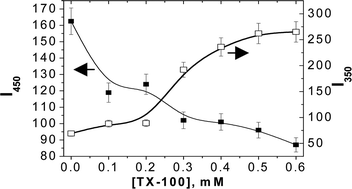Fluorimetric studies on the binding of 4-(dimethylamino)cinnamic acid with micelles and bovine serum albumin
Abstract
The constrained photophysics of intramolecular charge transfer (ICT) probe

* Corresponding authors
a
Department of Chemistry, North-Eastern Hill University, NEHU Permanent Campus, Umshing, Shillong, India
E-mail:
smitra@nehu.ac.in
Fax: +91-364-255 0486
Tel: +91-364-272 2634
The constrained photophysics of intramolecular charge transfer (ICT) probe

 Please wait while we load your content...
Something went wrong. Try again?
Please wait while we load your content...
Something went wrong. Try again?
T. S. Singh and S. Mitra, Photochem. Photobiol. Sci., 2008, 7, 1063 DOI: 10.1039/B717475F
To request permission to reproduce material from this article, please go to the Copyright Clearance Center request page.
If you are an author contributing to an RSC publication, you do not need to request permission provided correct acknowledgement is given.
If you are the author of this article, you do not need to request permission to reproduce figures and diagrams provided correct acknowledgement is given. If you want to reproduce the whole article in a third-party publication (excluding your thesis/dissertation for which permission is not required) please go to the Copyright Clearance Center request page.
Read more about how to correctly acknowledge RSC content.
 Fetching data from CrossRef.
Fetching data from CrossRef.
This may take some time to load.
Loading related content
